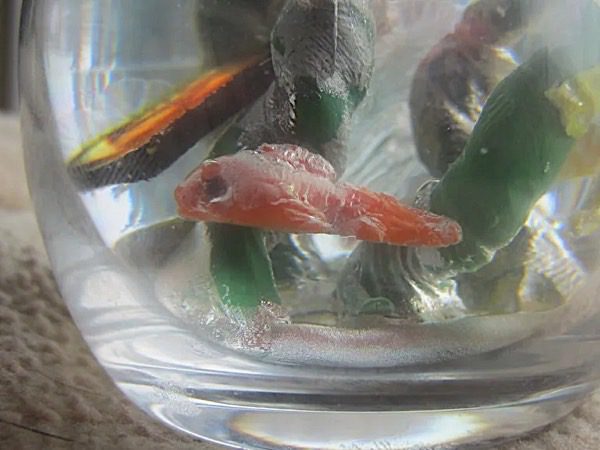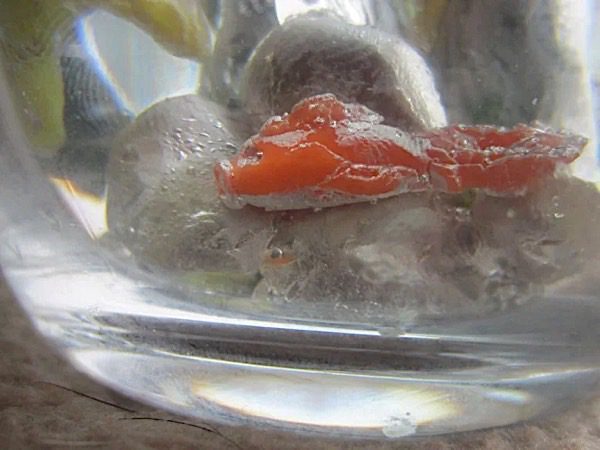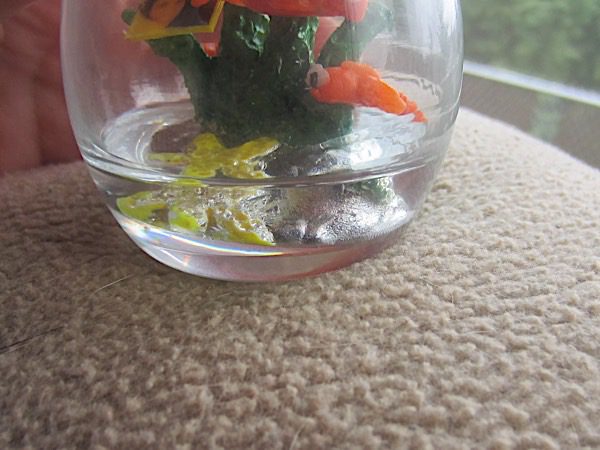Tagged: resin-troubleshooting
- This topic has 8 replies, 2 voices, and was last updated 8 years, 2 months ago by
Nicole.
-
AuthorPosts
-
-
February 16, 2016 at 2:30 pm #5083
Katherine Swift
KeymasterThis question comes through email by Julie:
I love your website and I am a resin newbie. I am having an issue in which I have looked high and low on to get information on. There was one post in your forum regarding “silvering” that came close to my issue but not quite.
I am using Easy Cast and following instructions to a t. I am using polymer clay. Once baked I then glue the item to the bottom of a small glass bowl. I poured all at once, tried another project in layers, and am still having the issue. I have NOT had the issue in standard molds, only in glass. I did NOT seal the clay for one, I sealed the clay with floor wax on the other. Same results on both.
I also have an email in to the company.
I have attached 3 images. The ONLY problem is on the clay embellishments. The resin is curing fine and is clear.
Any suggestions or help would be so much appreciated!
-
February 16, 2016 at 2:39 pm #5089
Katherine Swift
KeymasterHi Julie,
My thought here is that the film you see is air trapped next to your embedments. It could be from air released from the object during casting. Resin curing is a heat reaction. Sometimes that heat can cause air to be release during the curing process. The other possibility is that the surface tension of the embedded objects is trapping air. I don’t think the resin is a problem since you mentioned things are curing normally.
Here are a few suggestions on what you can try to prevent this in the future:
1. Dip your pieces in resin and allow them to cure on wax paper before embedding them in your fish bowl. That will reduce the surface tension. It will also seal any air in.
2. Seal the items with a two to three layers of our acrylic sealer spray before embedding. This will also seal air in.
3. Make sure your items are warm before including in the resin. That may allow air to escape before you put it in the resin. If I were going to do this, I would warm them up gently with a heat gun. https://shop.resinobsession.com/products/zap-embossing-heat-tool It wouldn’t be a bad idea to make sure your fish bowl is warm as well.
Let us know if this helps!
-
February 17, 2016 at 7:26 am #5096
Julie
GuestI did SEAL them with the craft resin sealer 2x and still did not work. I do have messages in to the manufacturer and they said to seal it as well. I have not dipped the items in resin prior to immersing them in resin. Will putting the clay and bowl under a lamp be good enough? Will warming the glass bowl in the microwave for a few seconds work? I was under the assumption if all items are “house” temperature 70 deg..they would be okay. Sigh….I know, trial and error, trial and error 🙂
-
February 17, 2016 at 3:35 pm #5098
Katherine Swift
KeymasterI would try using the clay and bowl with the lamp in a hot box shown here: https://www.resinobsession.com/resin-resin-resin/casting-resin-in-cold-temperatures The box will help keep the heat in.
I don’t know about warming the bowl in the microwave. I’m worried it would create hot spots (similar to reheating food) that may impact curing. Instead, I would put the bowl in a hot water bath to make sure it is warmed up evenly. Assuming it’s winter where you are, I don’t think house temperature is warm enough for inanimate objects. If you try heating the bowl in the microwave, let me know if that works.
-
February 19, 2016 at 6:01 pm #5124
stevie
GuestHi! i’ve had problems like this too. what worked for me was to either dip the embed in resin before placing it in, or, in a case like yours where the embed is already attached, brush on wet resin to thoroughly coat (thick!), and then pour the rest of the resin right away while still lquid. i don’tknow the scientific properties of why it works, but the liquids just mesh together without creating the air bubbles. Hope this helps!
-
February 23, 2016 at 4:38 am #5135
Julie
GuestI am now on my fifth fish bowl and I am still getting terrible results. I
did coat my polymer project with resin two times. I also sprayed my project
twice with Castin Craft Resin spray. After it dried I heated items under a
desk lamp and kept all items warm while curing. It seemed as if the clay did
“okay” but I am now getting the “force shield” result in the middle of
everything. I used 8oz of Castin Craft casting resin and 16 drops of
catalyst. Ugh..I am sooo frustrated. I am not sure how to attach pictures to this to show. Do I have to wait until SUMMER?????? When it is HOT all over? I am in Oregon and it is not cold. Sigh.. -
February 23, 2016 at 12:55 pm #5136
Katherine Swift
KeymasterHave you thought about using an epoxy? Polyester resin can be quite fussy in that the depth of the casting dictates how much catalyst you are using. I don’t know how deep you cast the resin, but 16 drop is a lot of catalyst. I’m wondering if your resin is getting too hot? Do you have a picture of the results this time?
-
February 26, 2016 at 6:22 am #5145
julie
GuestWill post soon….have been conversing with manufacturer of resin and now have an email in to sculpty. Purchased floral resin and am trying that.
-
March 1, 2016 at 4:12 am #5183
Nicole
GuestHello! I may be able to help, I do a lot of work in polymer clay and have several years experience in both resin and polymer clay, and I have used them together several times also. I remember having the same issues…. the “force field” of bubbles. Are you pouring a very “deep” or thick layer over your pieces, for the first layer?? Sometimes that can trap more bubbles (polymer clay definitely does release air bubbles when it “reacts” with the resin, whether or not you seal it) I have found that I have to pour a VERY thin layer, covering my clay items and once that is fully cured continue on from there. I also found that pouring the resin in from the sides and letting it “seep” in around the clay pieces helped me too… not pouring directly above or onto the clay pieces. I hope that you have found an answer and that your project works out!!! Good luck! 🙂
-
-
AuthorPosts
- The topic ‘Film on embedded objects’ is closed to new replies.




